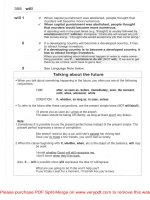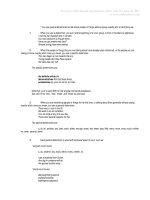Turbocharge your GMAT sentence correction guide part 3 pdf
Bạn đang xem bản rút gọn của tài liệu. Xem và tải ngay bản đầy đủ của tài liệu tại đây (71.5 KB, 7 trang )
Sentence Correction Guide – Grammar Review 6
1.3 Adjective
1.3.1 Usage
An adjective is a descriptive word which qualifies a noun, making it more specific:
The red car.
The old red car.
The big old red car.
The two young professors lived in Greewich Village.
A bright light flashed through the window of the house.
Adjectives are usually arranged in the order of specificity. Words normally used to perform other grammatical functions may be
used as adjectives. These can be recognized by their position before the noun to which they apply:
remote-control car
war effort
Christmas cookies
spring carnival
Adjectives can also be used to form a predicate with the verb to be:
Chocolate is yummy.
Normally, only ‘true’ adjectives can be used to form this kind of predicate. It is not possible to say:
Wrong: The cookies were Christmas,or
Wrong: The carnival was spring.
In such cases, it is necessary to use the prop-word, one:
The cookies were Christmas ones.
There are three forms of a ‘true’ adjective.
Normal: big beautiful
Comparative: bigger more beautiful
Superlative: biggest most beautiful
No agreement to noun is necessary for an adjective.
Student Notes:
www.manhattanreview.com
c
1999 - 2008 Manhattan Review
Sentence Correction Guide – Grammar Review 7
1.4 Adverb
An adverb is a part of speech used mainly to modify verbs but also adjectives and other adverbs. Adverbs describe how, where or
when.
1.4.1 Adverbial Forms
Adverbs are formed in a few different ways:
Most adverbs are formed from adjectives by the addition of the ending “-ly” (as in suddenly, playfully, interestingly) or “-ally” after
words in -ic (as in, automatically).
Some adverbs are formed from nouns in combination with other suffixes: -wise (as in, clockwise, lengthwise) and -ward(s) (as in,
northwards, westwards, skyward).
Some common adverbs have no suffixes, as in: here/there, now, well, just.
Some adverbs can qualify other adverbs (the most common are intensifiers, such as very, as in “very quick”).
Some adverbs have the same form as their adjective counterpart, e.g., fast,long,first.
Not all words ending in -ly are adverbs: lovely, ungainly,andlikely are adjectives. The word only and early may be either.
1.4.2 Adverbial Positions
Adverbs modify verbs in the same way adjectives qualify nouns.
The adverb often follows the verb it modifies:
I shouted loudly to my friends across the theater.
Sometimes it precedes the verb:
I really wanted to talk to her.
Sometimes position determines meaning:
I think clearly. (My thinking is clear.)
I clearly think. (It is clear that I think.)
Where emphasis is needed, the adverb may be put first, and the verb and subject inverted:
Never have I seen such an ugly dog.
Student Notes:
www.manhattanreview.com
c
1999 - 2008 Manhattan Review
Sentence Correction Guide – Grammar Review 8
1.5 Adverb vs. Adjective
1.5.1 Position and Meaning
When adverbs are used to modify adjectives, it is important to work out the relationships between them:
She heard an odd, chilling sound.
She heard an oddly chilling sound.
If one is not careful it is easy to confuse whether a word is an adverb or an adjective, and in either case, which other word it is
modifying in the sentence.
The change from adjective to adverb can change the meaning drastically:
The centaur appeared quick.
The centaur appeared quickly.
In this example when the adjective is used, it appears that the centaur is quick, whereas when the adverb is used, it is the centaur’s
appearance which occurred quickly.
Good vs. well: When used as adjectives, good refers to morality or quality and well refers to health. However, only well canbeused
as adverb and good is always an adjective.
Correct:
I feel good about my work.
I feel well.
Iamwell.
I’m doing well.
Wrong: I am doing good.
1.5.2 Adverb and Adjective
Great care must be taken to align only with the word it actually modifies, because its positioning can affect the meaning of the
sentence:
I ate some peas only yesterday - I don’t need to eat any today.
I only atesomepeasyesterday-Ididn’tdoanythingelse.
I ate only somepeasyesterday-Ididn’teatanythingelse.
Only I ate some peas yesterday - nobody else had any.
Early may be both adjective and adverb:
I take the early train.
Igetupearly to take the train.
www.manhattanreview.com
c
1999 - 2008 Manhattan Review
Sentence Correction Guide – Grammar Review 9
1.5.3 Adjective Only
Notice that some verbs may take adjectives to complete the meaning required (complementary adjectives). These verbs cannot
form a complete thought without the required adjectives:
He looks confused today.
The music seemed loud.
L
ikely
Special care must be taken with the adjective likely. It is often mistaken for an adverb because of its form, but this is not an acceptable
usage, for example:
Correct: The Republic is likely to fall.
Wrong: The Republic will likely fall.
L
ike (used as adjective or preposition)
Like, with its opposite unlike, should be treated as an adjective or a preposition; that is, it must always have a noun to relate to. A
predicate is formed with the verb to be:
Life is like a box of chocolates. (Life resembles a box of chocolates.)
Used in the form of a phrase, like will link two nouns (or noun phrases) of the same kind. In this case, like functions as a preposition,
a phrase-maker, and it is categorized so in some grammar books.
Like any politician, he often told half-truths.
L
ike vs Such As
In the above example, like is used to introduce similarity between two items or persons. This is an accepted usage in Sentence
Correction on the GMAT. In other words, like cannot be used to introduce examples or a subset of a category, which should be used
following such as.
Correct: I enjoy playing musical instruments such as piano and violin.
Wrong: I enjoy playing musical instruments like piano and violin.
In sum, on the GMAT, use like before a noun or pronoun when emphasizing similar characteristics between two persons, groups or
things. Use such as before a noun or phrase when introducing examples.
L
ike vs. As/As If/As though
Use like before a noun or pronoun. Use as before a clause, adverb or prepositional phrase. Use as if and as though before a clause.
Like is generally used as a preposition in such a context. As is generally used as an adverb while sometimes serving as a preposition
with the meaning of “in the capacity of”. As you can tell, the focus of the comparison shifts from the noun when used with like to
theverbwhenusedwithas, as if,oras though.
My mother’s cheesecake tastes like glue.
I love frozen pizza because there is no other snack like it.
My mother’s cheesecake tastes great, as a mother’s cheesecake should.
There are times, as now, that learning grammar becomes important.
He golfed well again, as in the tournament last year.
He served as captain in the navy.
He often told half-truths, as any politician would.
www.manhattanreview.com
c
1999 - 2008 Manhattan Review
Sentence Correction Guide – Grammar Review 10
He looks as if he knows me.
It looked as if a storm were on the way.
He yelled at me as though it were my fault.
The same rule applies when you use the expressions seem like and look like.
Correct:
He seemed like a nice guy at first.
That looks like a very tasty cake.
Wrong:Itseemed like he liked me.
Correct:Itseemed as if he liked me.
Here the comparison is with a clause, not a noun.
D
ue to
Due to is also used adjectivally, and must have a noun to attach itself to:
My failure, due to a long-term illness during the semester, was disappointing.
(That is, the failure was attributable to the long-term illness, not the disappointment, which would have had other causes, such as the
failure.)
O
wing to
If an adverbial link is needed, the expression owing to has lost its exclusively adjectival quality:
My failure was disappointing owing to a long-term illness during the semester.
(In this case, the disappointment at the failure was caused by the long-term illness during the semester.)
1.6 Preposition
Prepositions are words that are placed before a noun making a particular relationship between it and the word to which it is attached.
1.6.1 Preposition Types
There are a few types of prepositions:
1) simple prepositions: these are the most common prepositions, such as: in, on, of, at, from, among, between, over, with, through,
without.
2) compound prepositions: two prepositions used together as one, such as: into, onto/on to (on to is British English, onto is
American English), out of.
3) complex prepositions: a two- or three-word phrase that functions in the same way as a simple preposition, as in: according to,
as well as, except for, in favor of.
Preposition i.e. pre position. Prepositions always occur before the thing they refer to.
In: I was born in that house. (Here that house is the object of the preposition in)
Prepositional phrases may be adjectival or adverbial, according to what they modify:
www.manhattanreview.com
c
1999 - 2008 Manhattan Review
Sentence Correction Guide – Grammar Review 12
I went at Roger with a bat.
What’s wrong with this sentence? Nothing actually, it is grammatically correct. It is simply an odd usage of the prepositions.
Be careful to use the right preposition for the meaning you want; agree with differs in meaning from agree to, compare with is
distinct from compare to, and so on.
The expressions superior to, preferable to and different from are the only standard forms.
Student Notes:
1.6.3 Idioms with Prepositions
A
a sequence of
in accordance with
be accused of
acquiesce in
access to
adhere to, be an adherent of (follower)
affinity with
be afraid of
agree with (a person/idea)
agree to (a proposal or action)
aim at
allow for
an instance of
analogy with, analogous to
be attended by (not with)
attend to
appeal to (a person)
approval of
as a result of
associate with
attribute A to B (B is attributed to A)
authority on
B
www.manhattanreview.com
c
1999 - 2008 Manhattan Review









